1996 NISSAN FRONTIER child seat
[x] Cancel search: child seatPage 1 of 198

Foreword
Welcome to the growing family of new NISSAN owners. This vehicle has been delivered to you with confidence. It was produced using the
latest techniques and strict quality control.
This manual was prepared to help you understand the operation and maintenance of your vehicle so that you may enjoy many miles of
driving pleasure. Please read through this manual before operating your vehicle.
A separate ``Warranty Information Booklet'' explains details about the warranties covering your vehicle.
Your NISSAN dealer knows your vehicle best. When you require any service or have any questions, he will be glad to assist you with the
extensive resources available to him.
IMPORTANT SAFETY INFORMATION
REMINDERS FOR SAFETY!
Follow these five important driving rules to help ensure a safe and
complete trip for you and your passengers
²NEVER drive under the influence of alcohol or drugs.
²ALWAYS observe posted speed limits and never drive too
fast for conditions.
²ALWAYS use your seat belts and appropriate child restraint
systems.
²ALWAYS provide information about the proper use of vehicle
safety features to all occupants of the vehicle.
²ALWAYS review this owner's manual for important safety
information.
NOTES ON THE INFORMATION CONTAINED IN
THIS OWNER'S MANUAL
This owner's manual contains descriptions and operating in-
structions for all systems, features and optional equipment that
might appear in any model of this vehicle built for any destina-
tion in North America, including the continental United States,
Canada and Hawaii. Therefore, you may very well find informa-
tion in this manual that does not apply to your vehicle.
For descriptions specified for 4-wheel drive models, a
mark
is placed at the beginning of the applicable sections/items.
As with other vehicles with features for off-road use, failure to
operate 4-wheel drive models correctly may result in loss of
control or an accident. Be sure to read ``Driving 4-Wheel Drive
Safely'' in the ``Starting and driving'' section of this manual.
The inside pages of this manual contain
a minimum of 50% recycled fibers,
including 10% post-consumer fibers.
Page 26 of 198
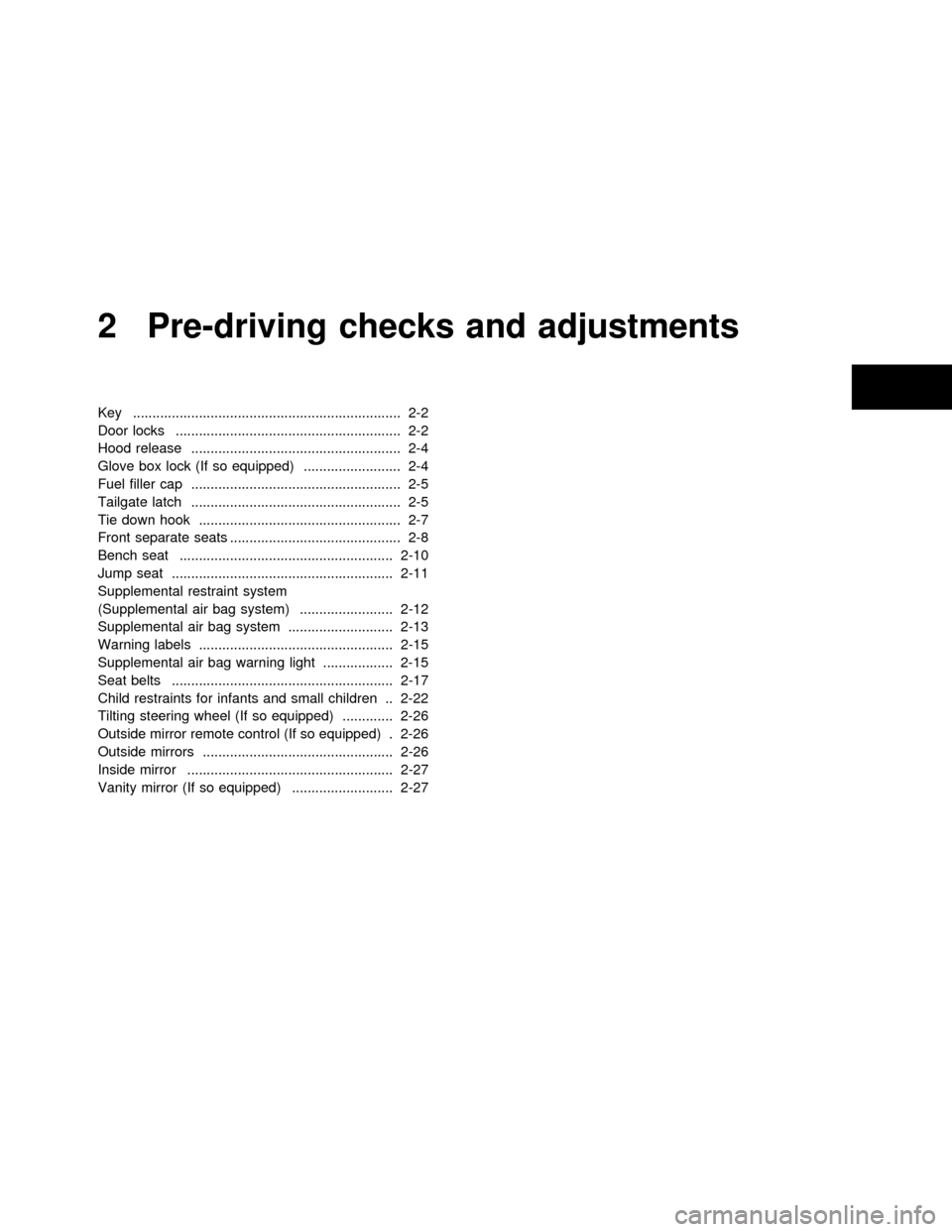
2 Pre-driving checks and adjustments
Key ..................................................................... 2-2
Door locks .......................................................... 2-2
Hood release ...................................................... 2-4
Glove box lock (If so equipped) ......................... 2-4
Fuel filler cap ...................................................... 2-5
Tailgate latch ...................................................... 2-5
Tie down hook .................................................... 2-7
Front separate seats ............................................ 2-8
Bench seat ....................................................... 2-10
Jump seat ......................................................... 2-11
Supplemental restraint system
(Supplemental air bag system) ........................ 2-12
Supplemental air bag system ........................... 2-13
Warning labels .................................................. 2-15
Supplemental air bag warning light .................. 2-15
Seat belts ......................................................... 2-17
Child restraints for infants and small children .. 2-22
Tilting steering wheel (If so equipped) ............. 2-26
Outside mirror remote control (If so equipped) . 2-26
Outside mirrors ................................................. 2-26
Inside mirror ..................................................... 2-27
Vanity mirror (If so equipped) .......................... 2-27
ZX
Page 36 of 198
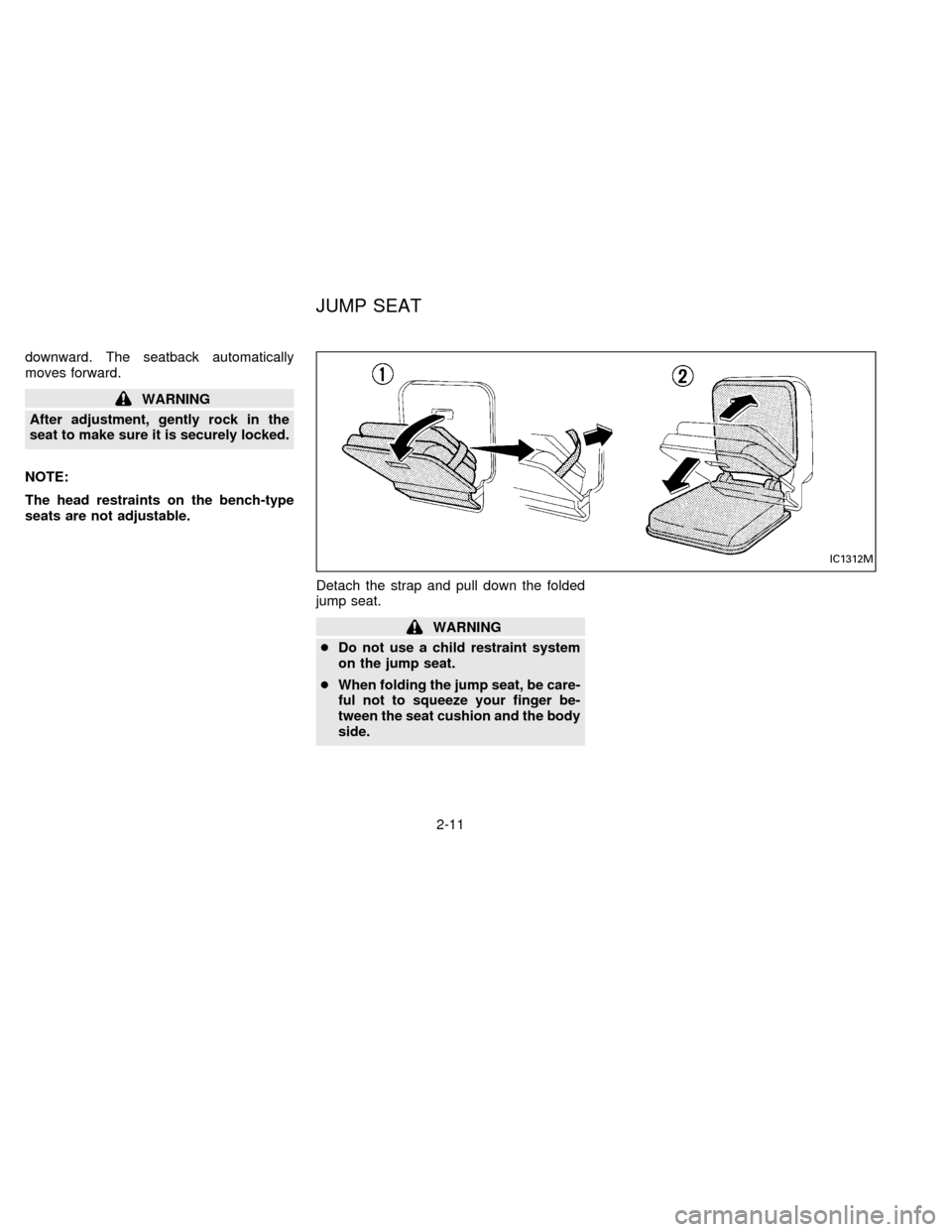
downward. The seatback automatically
moves forward.
WARNING
After adjustment, gently rock in the
seat to make sure it is securely locked.
NOTE:
The head restraints on the bench-type
seats are not adjustable.
Detach the strap and pull down the folded
jump seat.
WARNING
cDo not use a child restraint system
on the jump seat.
cWhen folding the jump seat, be care-
ful not to squeeze your finger be-
tween the seat cushion and the body
side.
IC1312M
JUMP SEAT
2-11
ZX
Page 42 of 198
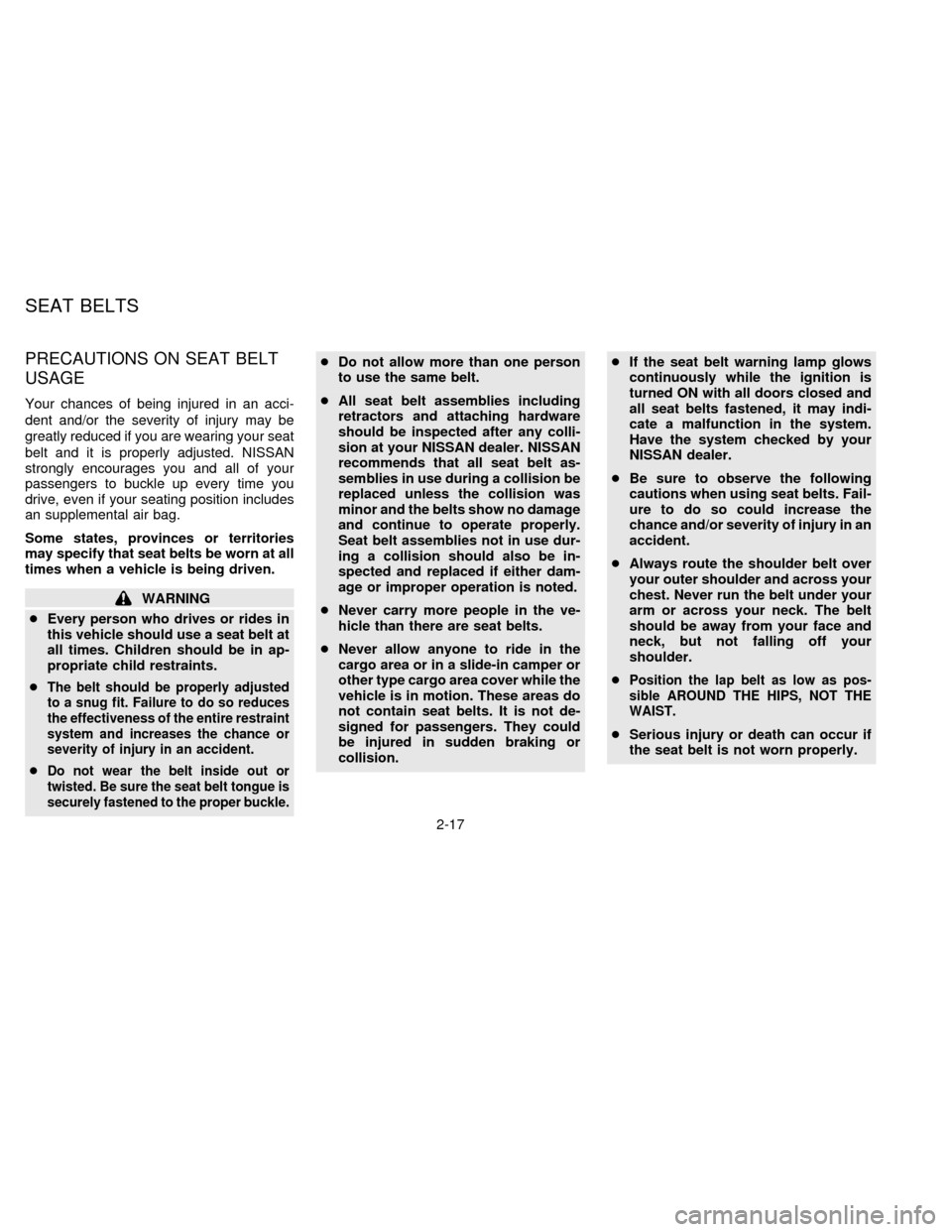
PRECAUTIONS ON SEAT BELT
USAGE
Your chances of being injured in an acci-
dent and/or the severity of injury may be
greatly reduced if you are wearing your seat
belt and it is properly adjusted. NISSAN
strongly encourages you and all of your
passengers to buckle up every time you
drive, even if your seating position includes
an supplemental air bag.
Some states, provinces or territories
may specify that seat belts be worn at all
times when a vehicle is being driven.
WARNING
cEvery person who drives or rides in
this vehicle should use a seat belt at
all times. Children should be in ap-
propriate child restraints.
c
The belt should be properly adjusted
to a snug fit. Failure to do so reduces
the effectiveness of the entire restraint
system and increases the chance or
severity of injury in an accident.
cDo not wear the belt inside out or
twisted. Be sure the seat belt tongue is
securely fastened to the proper buckle.
cDo not allow more than one person
to use the same belt.
cAll seat belt assemblies including
retractors and attaching hardware
should be inspected after any colli-
sion at your NISSAN dealer. NISSAN
recommends that all seat belt as-
semblies in use during a collision be
replaced unless the collision was
minor and the belts show no damage
and continue to operate properly.
Seat belt assemblies not in use dur-
ing a collision should also be in-
spected and replaced if either dam-
age or improper operation is noted.
cNever carry more people in the ve-
hicle than there are seat belts.
cNever allow anyone to ride in the
cargo area or in a slide-in camper or
other type cargo area cover while the
vehicle is in motion. These areas do
not contain seat belts. It is not de-
signed for passengers. They could
be injured in sudden braking or
collision.cIf the seat belt warning lamp glows
continuously while the ignition is
turned ON with all doors closed and
all seat belts fastened, it may indi-
cate a malfunction in the system.
Have the system checked by your
NISSAN dealer.
cBe sure to observe the following
cautions when using seat belts. Fail-
ure to do so could increase the
chance and/or severity of injury in an
accident.
cAlways route the shoulder belt over
your outer shoulder and across your
chest. Never run the belt under your
arm or across your neck. The belt
should be away from your face and
neck, but not falling off your
shoulder.
c
Position the lap belt as low as pos-
sible AROUND THE HIPS, NOT THE
WAIST.
cSerious injury or death can occur if
the seat belt is not worn properly.
SEAT BELTS
2-17
ZX
Page 43 of 198
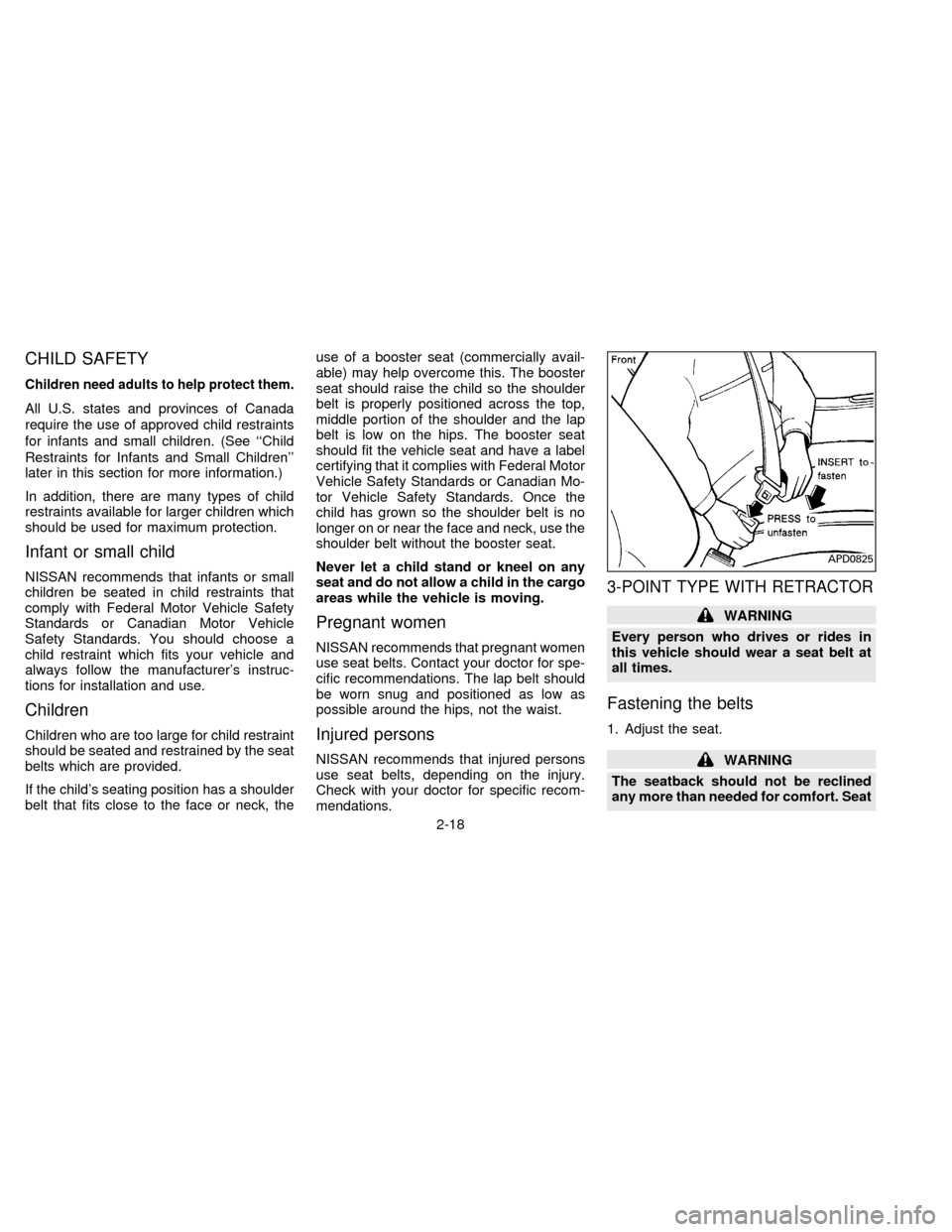
CHILD SAFETY
Children need adults to help protect them.
All U.S. states and provinces of Canada
require the use of approved child restraints
for infants and small children. (See ``Child
Restraints for Infants and Small Children''
later in this section for more information.)
In addition, there are many types of child
restraints available for larger children which
should be used for maximum protection.
Infant or small child
NISSAN recommends that infants or small
children be seated in child restraints that
comply with Federal Motor Vehicle Safety
Standards or Canadian Motor Vehicle
Safety Standards. You should choose a
child restraint which fits your vehicle and
always follow the manufacturer's instruc-
tions for installation and use.
Children
Children who are too large for child restraint
should be seated and restrained by the seat
belts which are provided.
If the child's seating position has a shoulder
belt that fits close to the face or neck, theuse of a booster seat (commercially avail-
able) may help overcome this. The booster
seat should raise the child so the shoulder
belt is properly positioned across the top,
middle portion of the shoulder and the lap
belt is low on the hips. The booster seat
should fit the vehicle seat and have a label
certifying that it complies with Federal Motor
Vehicle Safety Standards or Canadian Mo-
tor Vehicle Safety Standards. Once the
child has grown so the shoulder belt is no
longer on or near the face and neck, use the
shoulder belt without the booster seat.
Never let a child stand or kneel on any
seat and do not allow a child in the cargo
areas while the vehicle is moving.
Pregnant women
NISSAN recommends that pregnant women
use seat belts. Contact your doctor for spe-
cific recommendations. The lap belt should
be worn snug and positioned as low as
possible around the hips, not the waist.
Injured persons
NISSAN recommends that injured persons
use seat belts, depending on the injury.
Check with your doctor for specific recom-
mendations.
3-POINT TYPE WITH RETRACTOR
WARNING
Every person who drives or rides in
this vehicle should wear a seat belt at
all times.
Fastening the belts
1. Adjust the seat.
WARNING
The seatback should not be reclined
any more than needed for comfort. Seat
APD0825
2-18
ZX
Page 44 of 198

belts are most effective when the pas-
senger sits well back and straight up in
the seat. If the seat is reclined, the risk
of sliding under the lap belt and being
injured is increased.
2. Slowly pull the seat belt out of the retrac-
tor and insert the tongue into the buckle
until it snaps.
The retractor is designed to lock during
a sudden stop or on impact. A slow
pulling motion permits the belt to move,
and allows you some freedom of move-
ment in the seat.
3. Position the lap belt portionlow on the
hipsas shown.
4. Pull the shoulder belt portion toward the
retractor to take up extra slack.
The front seat passenger side seat belt has
a cinching mechanism for child seat instal-
lation. It is referred to as the automatic
locking mode.When the cinching mechanism is activated
the seat belt cannot be withdrawn again
until the seat belt tongue is detached from
the buckle and fully retracted. Refer to
``Child restraints for infants and small chil-
dren'' later in this section for more informa-
tion.
WARNING
The automatic locking mode should be
used only for child seat installation.
During normal seat belt use by a pas-
senger, the locking mode should not be
activated. If it is activated it may cause
uncomfortable seat belt tension.
Unfastening the belts
To unfasten the belt, press the button on the
buckle. The seat belt automatically retracts.
Checking seat belt operation
Seat belt retractors are designed to lock belt
movement by two separate methods:
1) When the belt is pulled quickly from the
retractor.
2) When the vehicle slows down rapidly.
APD0827
2-19
ZX
Page 47 of 198
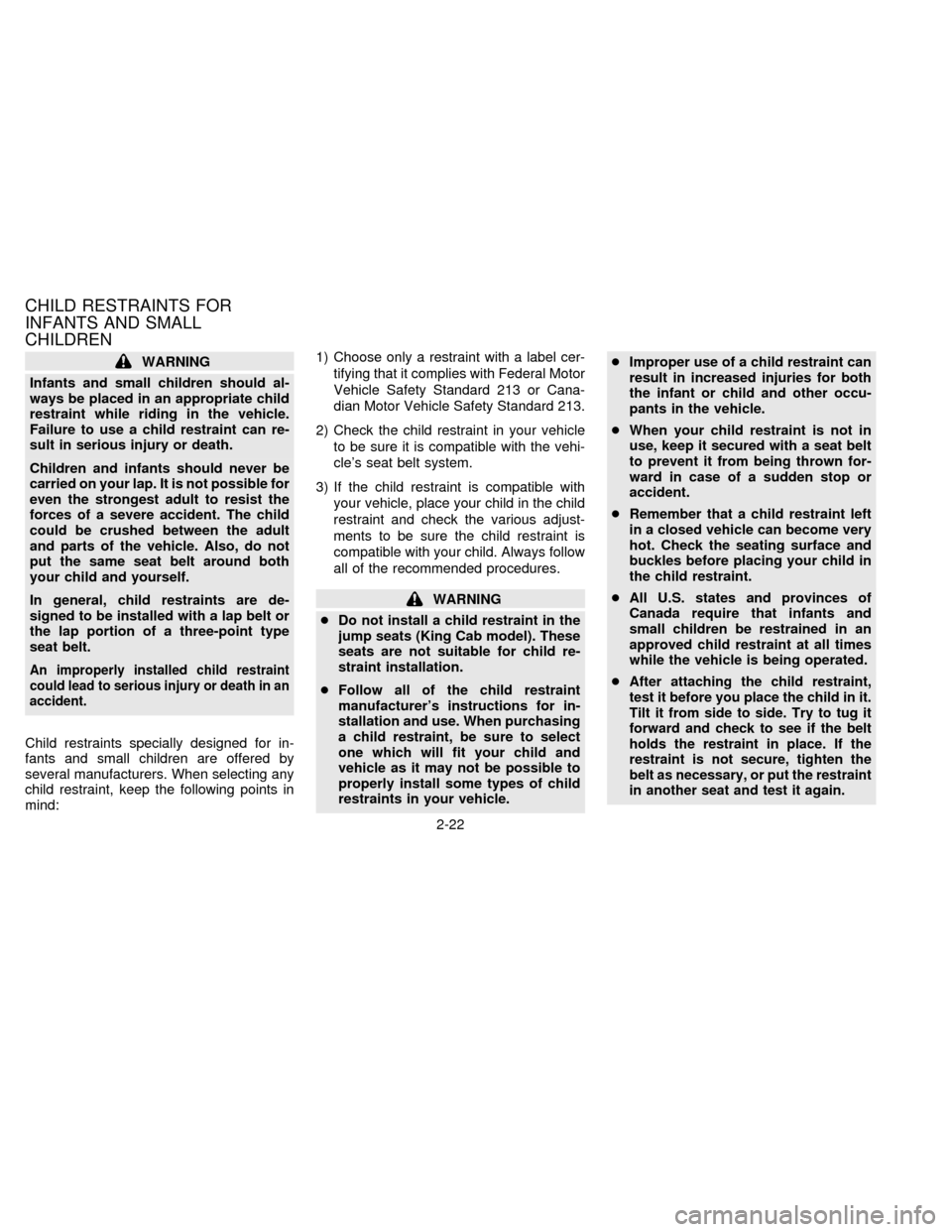
WARNING
Infants and small children should al-
ways be placed in an appropriate child
restraint while riding in the vehicle.
Failure to use a child restraint can re-
sult in serious injury or death.
Children and infants should never be
carried on your lap. It is not possible for
even the strongest adult to resist the
forces of a severe accident. The child
could be crushed between the adult
and parts of the vehicle. Also, do not
put the same seat belt around both
your child and yourself.
In general, child restraints are de-
signed to be installed with a lap belt or
the lap portion of a three-point type
seat belt.
An improperly installed child restraint
could lead to serious injury or death in an
accident.
Child restraints specially designed for in-
fants and small children are offered by
several manufacturers. When selecting any
child restraint, keep the following points in
mind:1) Choose only a restraint with a label cer-
tifying that it complies with Federal Motor
Vehicle Safety Standard 213 or Cana-
dian Motor Vehicle Safety Standard 213.
2) Check the child restraint in your vehicle
to be sure it is compatible with the vehi-
cle's seat belt system.
3) If the child restraint is compatible with
your vehicle, place your child in the child
restraint and check the various adjust-
ments to be sure the child restraint is
compatible with your child. Always follow
all of the recommended procedures.
WARNING
cDo not install a child restraint in the
jump seats (King Cab model). These
seats are not suitable for child re-
straint installation.
cFollow all of the child restraint
manufacturer's instructions for in-
stallation and use. When purchasing
a child restraint, be sure to select
one which will fit your child and
vehicle as it may not be possible to
properly install some types of child
restraints in your vehicle.cImproper use of a child restraint can
result in increased injuries for both
the infant or child and other occu-
pants in the vehicle.
cWhen your child restraint is not in
use, keep it secured with a seat belt
to prevent it from being thrown for-
ward in case of a sudden stop or
accident.
cRemember that a child restraint left
in a closed vehicle can become very
hot. Check the seating surface and
buckles before placing your child in
the child restraint.
cAll U.S. states and provinces of
Canada require that infants and
small children be restrained in an
approved child restraint at all times
while the vehicle is being operated.
c
After attaching the child restraint,
test it before you place the child in it.
Tilt it from side to side. Try to tug it
forward and check to see if the belt
holds the restraint in place. If the
restraint is not secure, tighten the
belt as necessary, or put the restraint
in another seat and test it again.
CHILD RESTRAINTS FOR
INFANTS AND SMALL
CHILDREN
2-22
ZX
Page 48 of 198
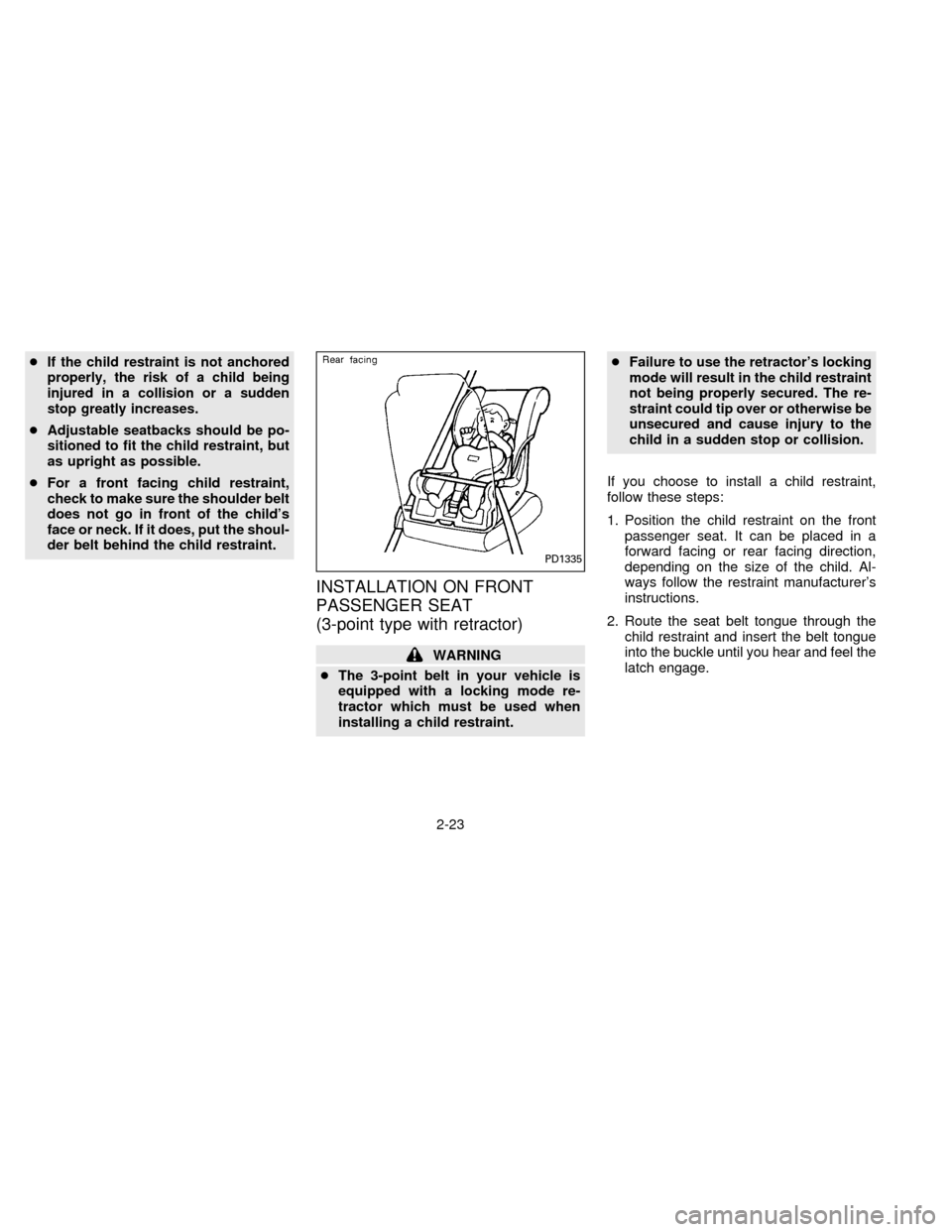
cIf the child restraint is not anchored
properly, the risk of a child being
injured in a collision or a sudden
stop greatly increases.
cAdjustable seatbacks should be po-
sitioned to fit the child restraint, but
as upright as possible.
cFor a front facing child restraint,
check to make sure the shoulder belt
does not go in front of the child's
face or neck. If it does, put the shoul-
der belt behind the child restraint.
INSTALLATION ON FRONT
PASSENGER SEAT
(3-point type with retractor)
WARNING
cThe 3-point belt in your vehicle is
equipped with a locking mode re-
tractor which must be used when
installing a child restraint.cFailure to use the retractor's locking
mode will result in the child restraint
not being properly secured. The re-
straint could tip over or otherwise be
unsecured and cause injury to the
child in a sudden stop or collision.
If you choose to install a child restraint,
follow these steps:
1. Position the child restraint on the front
passenger seat. It can be placed in a
forward facing or rear facing direction,
depending on the size of the child. Al-
ways follow the restraint manufacturer's
instructions.
2. Route the seat belt tongue through the
child restraint and insert the belt tongue
into the buckle until you hear and feel the
latch engage.
PD1335
2-23
ZX